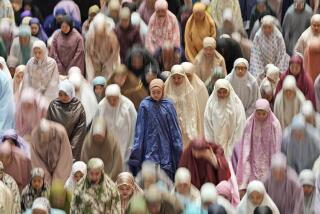Eight major world religions meet up in a book
When Akasha Lonsdale was a child in London, her agnostic family prohibited her from participating in religious services at the Church of England school she attended. Required to sit at the back of a Hebrew class for the school’s Jewish students, she befriended a girl whose family invited her to the Friday night Sabbath meal.
“I found it an enriching experience,” says Lonsdale, who years later became a therapist and then an interfaith minister. “Even from age 4, I was aware there was something more than this earthly life. I was on a spiritual quest from that age.”
Now Lonsdale, 57, has published “Do I Kneel or Do I Bow?,” a concise guide to the ceremonies of eight major world religions. The 336-page soft-cover book is divided into sections on the Roman Catholic, Protestant, Orthodox Christian, Jewish, Muslim, Hindu, Sikh and Buddhist faiths.
“There are many gateways to God and truth,” she said. “Spirituality can exist independently of religion, but the core of all religions is spiritual.”
Lonsdale describes her book as a labor of love, and says it is aimed at those moments when we find ourselves outside our comfort zones, wanting to do the right thing and not offend, while venturing into religious settings we know little about.
In our multicultural society, a Sikh may invite a Muslim colleague to a family wedding. A Jew may invite a Catholic neighbor to a bar mitzvah. Or a Protestant raised in America may visit an Eastern Orthodox Church while traveling.
According to the book, which was vetted by clerics of all eight faiths, it would be offensive for a man to take his hat off in a Sikh temple or a synagogue, but the opposite could be true in some churches. One should not bring flowers to a Jewish or Muslim funeral, whereas they would be welcomed by Christians, Hindus and Buddhists.
Each section of the book contains a summary of the religion’s tenets. Then there are descriptions of holidays and rituals, and user-friendly boxes titled “What Happens?” and “What Should I Do?”
In Britain, an Anglican bishop might kneel and wash the feet of parishioners on Maundy Thursday before Easter. But it would be deeply offensive to direct the soles of one’s feet toward the religious leader in a mandir, a Hindu place of worship.
“This means you won’t be able to stretch your legs out if you are uncomfortable sitting cross-legged,” writes Lonsdale. “If you feel unable to hold this position for about an hour, you can sit on a chair at the back.”
Those seeking the reasons behind all the rituals and practices will have to consult more comprehensive tomes.
“I had to really discipline myself and rein it in. It was very easy to go off on a tangent,” Lonsdale said. “The book could have been twice the size. But my focus was to have it be about ceremonies, from the perspective of the guest.”
She also knows that there are many different streams of thought within the religions and it would be impossible “to get the pitch right” for everyone.
“There are going to be people who don’t agree. There will be many different interpretations,” she said. Still, she believes a baseline understanding of the major religions is a matter of daily life these days, not just something for those taking world religion classes.
For Lonsdale, the guidebook is the culmination of a lifelong search for spiritual meaning, which ultimately led her to an interfaith ministry. She began in adolescence to read about the various spiritual traditions but never felt comfortable with dogma or choosing the “right” version.
“Each time I came to a door of a particular faith, I hesitated because it was presented as the one way,” she recalls.
At the same time, Lonsdale developed a great respect for religious traditions. She did not feel the need to reject religion, as do many people who become disaffected with mainstream, institutional forms of worship.
Eventually, she discovered that Hinduism takes one of the more liberal approaches to spiritual life and so she incorporates chanting and meditation into her own spiritual practice.
Two decades ago, Lonsdale took the spiritual name Akasha, Sanskrit for “eternal wisdom,” but kept it largely private as she built her therapy practice and wrote a self-help book with pointers for living powerfully.
It wasn’t until 2004 that Lonsdale became aware of London’s Interfaith Foundation and entered its two-year seminary program to become an ordained interfaith minister. By 2005, Akasha had become her legal first name, replacing her given name Perry.
Now, in addition to her spiritually oriented therapy practice, Lonsdale creates personalized ceremonies for those who seek sacred services for birth, marriage and death, but do not feel comfortable with the mainstream approach. Her clients incorporate as little or as much traditional faith ritual as they like.
“Last year, I did a Hindu-Christian marriage that honored both backgrounds,” she said. “Particularly the younger generation, those in their mid-30s and younger, have grown up in a multicultural society and have friends of all faiths.”
Hence the guidebook, which she hopes will be viewed much like a dictionary that each home should possess.
As for kneeling, Jews don’t do it, but Catholics do, and Muslims kneel and prostrate themselves. When it comes to bowing, Hindus put their palms together for the namaste bow of reverence and thanks, whereas Buddhists bow with hands cupped — just fingertips and palms touching -- to emulate the shape of the lotus bud.
More to Read
Sign up for Essential California
The most important California stories and recommendations in your inbox every morning.
You may occasionally receive promotional content from the Los Angeles Times.










